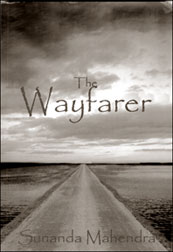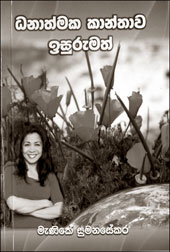
The Wayfarer
A novel by Sunanda Mahendra
Sarasavi Publishers, Nugegoda.
First Edition 2007
Reviewed by Prof. Kamani Jayasekera
Prof. Sunanda Mahendra has always struck me as a person who was not
afraid to think. To venture out to the not too familiar vistas in our
day to day lives. Areas we have been conditioned to live with but not
given considerable recognition to.
 May be it is the sensitivity in his creativity that had led him to
examine and thereby lead the reader to pay attention to things that he
had been accustomed if not resigned to. May be it is the sensitivity in his creativity that had led him to
examine and thereby lead the reader to pay attention to things that he
had been accustomed if not resigned to.
Familiar to the Sinhala reader as a creative artist it is with The
Wayfarer that he enters the field of English Novel. The English readers
have known him as a critic and a scholar, with this attempt they get the
opportunity to experience him as a creative artist where he addresses
their innermost sensitivities. His voice is clear, though the loudness
is toned down by the maturity and insight.
In the novel Prof. Sunanda Mahendra addresses a social problem that
many a mature citizen faces in Sri Lanka. This is where the educated
upper middle class offsprings migrate in search of greener pastures.
The parents are thereby faced with the choice of living alone in Sri
Lanka or joining them abroad. Though many may accept this fate without
much protest, sensitive souls may not find it that simple. Though pros
and cons may be weighed either way, to them substantiality lies with the
inner core.
This is where individual choice transforms into an inner saga. A
subject where many would maintain their silence with a sense of loyalty
to their offsprings or due to the imagined necessity to keep up a
pretext in society, for social prestige may be.
Life according to the protagonist in the novel is too short to
'pretend' or to put up a 'pretext' for others to envy. Quality of life
is bound up with one's inner values and the choices one might be forced
to make. It would not be a choice if it was mearly a selection between
the positive and the negative.
It is the maturity of vision on the part of the author that becomes
visible in this context. The complexities that the wayfarer faces might
be difficult for one to reconcile with. But how fruitful would a
resentment that would bring disturbance be? Is it all worth it? Would
reconciliation or retaliation bring one inner peace? On reading The
Wayfarer we experience the quest almost amounting to a religious
journey.
Another aspect that one does not fail to notice is the cultural
setting. Experiencing the global village concept could one be uprooted
from one's soil and experience tranquillity of mind? Some may and some
may not. But the exposure of the novel makes one realise the existence
of such a problem.
The story is written in a lucid style which makes it enjoyable
reading although the impact it generates remains food for thought. The
division of the book is interesting. It is up to the writer to select
the mode most suitable.
Experiment and novelty is welcome to Lankan literature, specially
when it is done by a veteran like Prof. Sunanda Mahendra. Longinus, a
Roman literary theorist of the classical world commented that although
many may attribute the decline of literature to social and political
reasons, it is actually the quality of the choice and mind of the writer
that matters.
I was reminded of this when reading The Wayfarer.
Woman is equal to man
"Dhanathmaka Kanthava Isurumath"
Author: Menike Sumanasekara
27A, Malwatte Road, Kohuwala, Nugegoda
Reviewed by R.S. Karunaratne
Menike Sumanasekara, a leading positive thinking educator, has
treated another aspect of her pet subject by discussing how it affects
women in their day-to-day life. In the opening chapter she sees woman as
a wonderful creation of nature, woman is the epitome of beauty and
innocence.
 However, man has dominated her role by imposing numerous
restrictions. These come in the form of religious teachings or moral
codes. Such restrictions can be expected in a male-dominated world. However, man has dominated her role by imposing numerous
restrictions. These come in the form of religious teachings or moral
codes. Such restrictions can be expected in a male-dominated world.
The author is at pains to prove that woman is equal to man. She can
perform almost all the tasks done by man. However, when it comes to
payments and recognition, woman receives step-motherly treatment.
In the developed world, women have proved their capabilities as Heads
of States and leading figures in the academic and management fields. But
the role of women in developing countries is far from satisfactory.
Sumanasekara sees youth as the season of spring in life. But our life
is full of uncertainties. You can fall sick at any time. Death may visit
at the most unexpected moment. Despite this impermanence, woman has a
role to play. She is the giver of life to her children who become
tomorrow's citizens.
Therefore from the very beginning all human beings come under the
influence of women. As mothers they have to mould the character of
children. If they fail in their duties, future generation is doomed.
Meanwhile, motherhood is a sacred institution. A mother is the first
teacher to her children. She has to guide their destinies without
expecting anything in return.
The author points out that the present deterioration of ethical
standards is due to mother's failure to fulfil her duties. If she
performs her duties well, the child can develop his faculties under
school teachers.
Quoting research findings the author tells us that many children
prosper in later life as a result of their female teachers' guidance.
The book extols the virtues of marriage. Without a properly
maintained family unit, we cannot build up our lives. Marriage between a
man and a woman is associated with many customs and rituals.
That shows the importance of marriage. All the religions have laid
down rules governing a happy marriage. The author says that it is futile
to rely on astrology to decide whether a particular person is good for
marriage.
The chapter on motherhood is illuminating. Only a woman can give
birth to a child. Therefore, she is a unique creation of nature.
The author stresses that a mother should lead a stress-free life in
order to give birth to a healthy baby. She has quoted the findings of
some research studies conducted in foreign countries that confirm her
views.
Taken as a whole "Dhanathmaka Kanthava Isurumath" is compulsory
reading for all women young and not-so-young. The author has considered
every aspect of a woman's life from the stand point of a positive
thinker. Therefore, the book stands out as a brilliant effort to lead
women on the correct path.
That act of transcreation
Can a translation be a "creation?":
by Vijita Fernando
It was Walter Benjamin who said that a pure translation is
"transparent, it does not cover the original, does not block its light,
but allows the pure language to shine upon the original all the more
fully."
Unhappily for people like me who believe in translations, during the
past few decades translations have been receiving somewhat step motherly
treatment by the English speaking literati here in Sri Lanka. Happily
that trend is now changing, especially with a few enlightened publishers
recognizing that translations are the traffic across linguistic and
cultural barriers and need to be recognized and supported as such.
A question that is often asked is, are translations creative. I
remember well what happened a few years back when a translation won the
prestigious Gratiaen award and the debate that it sparked off.
There were many who asked how a translation can be a creative work
when the plot, the characters, the narration all belong to the original
writer. What is missing in such an attitude is that a translation is not
a mere transfer from one language to another, that it is not a
mechanical interpretation.
It is a very different creative activity from creative writing as a
good translation requires both a sound knowledge of two languages and a
special kind of creativity which one can see when you read some of the
excellent translation we have today.
The creativity comes in the manner in which another's thoughts and
ideas, emotions and perceptions written in one language are transferred
to another. In such an exercise linguistic competence alone is not
enough.
The transfer from Sinhala or Tamil to English to convey the full
meaning of what the original writer intended cannot be done just because
the translator can read and understand the two languages, Sinhala and
English or Tamil and English as the case may be.
The transference requires special skills of exactitude if the
translator is to do justice to the original work that it deserves.
Certain nuances in the language, expressions, feelings, perceptions,
need careful thinking and handling in the new language. Though one may
be fluent in both languages it is not the easiest thing to do to
transfer or recreate the nuances of another's text to a completely new
language.
Thus translation is both a transference and a creation which the
American poet Robert Lowell termed very aptly, "an act of transcreation."
And that is what we find in any really good translation, a transcreation
where the translator has created a work of fiction which stands on its
own though it is a translation.
When you read such translations you are reading something entirely
new, a work which stands on its own and that, I believe, is the true
success of a good translation. Obviously translation does not happen in
vacuum, but in a continuum.
It is not an isolated fact, but part of a process of intercultural
transfer. Translation is also an activity that involves a number of
stages in the process of transfer across linguistic and cultural
boundaries.
In today's world of expanding communications, translations have
become the currency of exchange in the transfer of knowledge. We read
the works of Greek dramatists, the Sanskrit classics, the novels of
Russian masters, the Chinese, Indian, Japanese and Spanish in English or
in Sinhala and quite often forget that we are reading these works in
translation.
Only when a newer and better translation comes along are we made
aware of the fact that what we have known was a particular version of
the original text. It is a translation, even if flawed, that opens up
the world for us and gives us an insight into what the original would
have been, what the writer thought of, felt, perceived, loved or hated
in the original language.
Following up on the notion that translations re not creative is also
the idea that translation is necessarily inferior to the original or the
source. It is often looked upon as copy in another language. As far back
as 1931 Hillaire Bellock summed up this attitude in a way which I think
is applicable even today.
"The art of translation is a subsidiary art and is derivative. On
this account it has never gained the dignity of the original work, and
has suffered too much in the general judgment of letters.
This natural under estimation of its value has had the bad practical
effect of lowering standards demanded, and in some periods has destroyed
it altogether. The corresponding misunderstanding of its character has
added to its degradation, neither its importance nor its difficulty has
been grasped."
In Sri Lanka translations are the traffic between nations which
reflect the relationship between local languages, Indian or Sri Lankan
and the master language of the post colonial world, English.
When the very first translation into English of the Bhagvad Gita
appeared in India in 1765, Warren Hastings, the then Governor General of
India, remarked that "works such as this will survive when the British
dominion of India shall have long ceased to exist.'
It is not surprising then that the Bhagvad Gita circulates and
survives rather better today in English in the world and even in India
itself.
These are important pointers to the value of translation into English
of the fine body of resurging Sinhala and Tamil writing in Sri Lanka to
day for those who do not read the indigenous languages and thus are
deprived of an important aspect of their own culture.
I would like to end these few comments with the words of Miles Smith
who, when he wrote the preface to the King James Bible in 1611 said, "
translation it is that openeth the window to let in the light; that
breaketh the shell that we may eat the kernel."
In search of creative avenues
Title: Sandakatayama
Author: Shashi Prabhath Ranasinghe
Reviewed By Ranga Chandrarathne
Sadakatayama, a maiden anthology of poetry by young writer Shashi
Prabhath Ranasinghe was recently launched. Shashi, who has been
experimenting with various forms of poetry in Sinhala, for the first
time, came out with his own poetry on diverse themes.
 Some of his poems manifest the effective use of metaphor, idioms and
similes in creating mind pictures. For instance, the poem "Sakisada"
(Friend) is such a poem. Here he compares mind to a wall and diverse
thoughts to the graffiti on it. However, at the hand of an immature
artist, graffiti is being distorted and even the distorted graffiti
cannot be easily erased off owing to the sentiments attached to them. Some of his poems manifest the effective use of metaphor, idioms and
similes in creating mind pictures. For instance, the poem "Sakisada"
(Friend) is such a poem. Here he compares mind to a wall and diverse
thoughts to the graffiti on it. However, at the hand of an immature
artist, graffiti is being distorted and even the distorted graffiti
cannot be easily erased off owing to the sentiments attached to them.
A particular characteristics of his poetry are the use of blank verse
and brevity of expression. He has also used techniques such as
intonation and use of the same word to bring out different meanings to
create a poetic context.
However, in some poems, he has effectively destroyed the zest in his
attempt to keep the rhythm. In such instances he has used the poetic
metre of the Colombo school. For instance, his poem "Pathum Raya" the
last two lines have been used contrary to the meaning of the poem and
only to stick to the metre.
"Medum Saluven thama Daruvan se
Kadugata Poravana Raa Amma
Daka Masita Nithi Sali Rahase
Ama Hagum Pibidai Pemma"
The poem can be translated into English as "The mother of night
covers the mountains" children with a blanket of mist and lustful
thoughts come to my mind stealthy,". Sashi is successful at instances
where juxtaposing nature with human emotions. "Idoraya" (drought) is
such a poem in which the poet portrays a drought in an effective way.
In the title poem of the collection "Sadakatayama", the poet
manifests prominently distorting the rhythm of the poem. It seems that
the natural sequence of thoughts has been disturbed by the intervention
of the poet to force insert his ideas into the poem. The moon portrayed
in the poem is not a pleasant one but a one which is under siege (moon
is compared to a prostitute).
Though the collection has constructive ideas and ironically attached
writers who idealises the life in the village, some ideas are irrational
and apparently born out of ignorance on the part of the poem.
The poem "Young Poet" is a poem which shows the poet's mean
understanding on world literature and Shakespeare's work. One may
entertain one's preferences with regard to the studying of poetry,
however, one could not afford to jettison the body of work overboard
just to follow a Japanese poet.
Shashi should be encouraged for his boldness in experimenting with
Sinhala poetry. However, he should also better exercise restrain in
passing judgments on what he is really ignorant of.
As a young poet Shashi has still room for perfection in terms of
language and the material that go into his poetry.
[email protected] |

